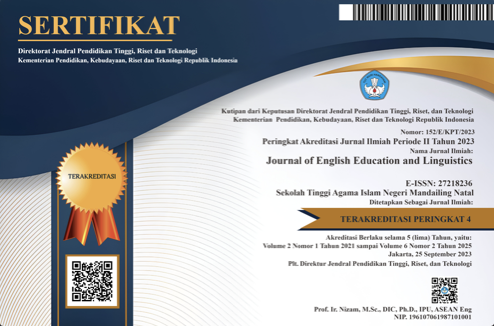A Causal Study of Role Play Technique and Drilling Vocabulary to the Students’ Speaking Ability
DOI:
https://doi.org/10.56874/jeel.v1i1.46Keywords:
Role Play, Vocabulary, SpeakingAbstract
In this era of Globalization, English Language is important for our lives. In fact, it is the second most spoken language in the world. Globalization made the use of English language more widen. The ability to speak and to write English property has been one essential benchmark skills in the professional world. The teacher can use some methods in teaching and learning process to help the students’ understanding. In this research, the researcher used role play technique and drilling vocabulary to enhance speaking skill. This research problems were; (1) Is there any influence of role play technique to the students’ speaking ability at SMA MUHAMMADIYAH TANJUNG REDEB?, (2) Is there any influence of drilling vocabulary to students’ speaking ability at SMA MUHAMMADIYAH TANJUNG REDEB?, (3) Is there any influence of role play technique and drilling vocabulary to the students’ speaking ability at SMA MUHMAMMADIYAH TANJUNG REDEB?. The method of this research is partial correlation method, The statistic value performed in level good correlation among Role play technique and drilling vocabulary to the students’ speaking ability during conducted for twelve at SMA Muhammadiyah Tanjung Redeb.
References
Averil Coxhead, (2006), Essentials of Teaching Academic Vocabulary, USA: Houghton Mifflin Company.
J.B. Heaton, Classroom Testing: Longman Keys to Language Teaching, (New York:Longman, 1990)
Jeremy Harmer, The Practice of English Language, (New York: Longman, 1989)
JO McDonough and Christopher Shaw, Materials and Methods in ELT, (Melbourne: Blackwell
Publishing, 2003)
Martyn Bygate, Language Teaching: A Scheme for Teacher Education; Speaking, (Oxford: Oxford University Press, 1997)
Penny Ur, A Course in Language Teaching, (Cambridge: Cambridge University Press,1996)
Linse, T Caroline. 2005. “Practical English Language Teaching: Young Learners”. New York: McGraw-Hill Companies, Inc.
Downloads
Published
Issue
Section
License
All articles published in the Journal of English Education and Linguistics are licensed under a Creative Commons Attribution-ShareAlike 4.0 International (CC BY-SA) license. This means anyone is free to copy, transform, or redistribute articles for any lawful purpose in any medium, provided they give appropriate attribution to the original author(s) and Journal of English Education and Linguistics, link to the license, indicate if changes were made, and redistribute any derivative work under the same license.
Copyright on articles is retained by the respective author(s) without restrictions. A non-exclusive license is granted to the Journal of English Education and Linguistics to publish the article and identify itself as its original publisher, along with the commercial right to include the article in a hardcopy issue for sale to libraries and individuals.
Although the conditions of the Creative Commons Attribution-ShareAlike 4.0 International (CC BY-SA) license do not apply to authors (as the copyright holder of your article, you have no restrictions on your rights), by submitting to the Journal of English Education and Linguistics, authors recognize the rights of readers and must grant any third party the right to use their articles to the extent provided by the license.

This work is licensed under a Creative Commons Attribution-ShareAlike 4.0 International License.








